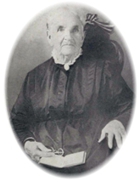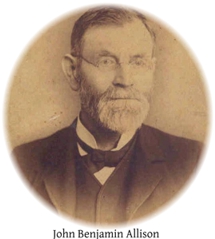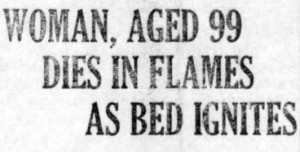 I can’t remember how I happened to stumble across the story of Elizabeth Mosby Woodson Allison – perhaps the tragic way she died caught my eye in a 1924 newspaper headline. By all accounts, she lived a full and long life, yet one of the most interesting aspects of Elizabeth’s life was her impressive family heritage.
I can’t remember how I happened to stumble across the story of Elizabeth Mosby Woodson Allison – perhaps the tragic way she died caught my eye in a 1924 newspaper headline. By all accounts, she lived a full and long life, yet one of the most interesting aspects of Elizabeth’s life was her impressive family heritage.
Elizabeth Mosby Woodson was born on December 30, 1824 in Franklin County, Virginia to parents Benjamin and Martha “Patsey” LeSueur Woodson. According to History of Monroe and Shelby Counties, Missouri, Benjamin “was a prominent teacher in the south-western part of Virginia.” Thus, his children received a good education. The family had connections to the well-known Virginia families of Woodson, LeSueur, Bacon and Randolph.
The LeSueurs were of French origin and traced their heritage back to Eustace LeSueur, a great French painter born in 1617 and referred to as the French Raphael. Other prominent LeSueur family members included Thomas LeSueur, a famous mathematician, and Peter LeSueur a wood engraver. The family’s immigrant ancestor in America, a French Huguenot named David LeSueur, came with Lafayette “to assist the colonies in their struggle for independence.”
 The family’s most impressive heritage came through the Randolph family and connected Elizabeth, a first cousin twice removed, to the third President of the United States, Thomas Jefferson. Elizabeth’s grandmother Nancy Anna “Nannie” Woodson (who apparently married her cousin John Stephens Woodson) was the first cousin of Jefferson through his mother’s Randolph line.
The family’s most impressive heritage came through the Randolph family and connected Elizabeth, a first cousin twice removed, to the third President of the United States, Thomas Jefferson. Elizabeth’s grandmother Nancy Anna “Nannie” Woodson (who apparently married her cousin John Stephens Woodson) was the first cousin of Jefferson through his mother’s Randolph line.
That connection alone was impressive enough for the life-long member of the Daughters of the American Revolution, but through the Randolph line Elizabeth was also a direct descendant of Pocohantas through her son Thomas Rolfe. If there was a “royal lineage” in America, this might come close to qualifying as such.
In 1840 Elizabeth and her family migrated to Monroe County, Missouri and were enumerated in Jackson for the 1840 census. In 1844 Benjamin purchased land to farm, but passed away in 1848 before Elizabeth married John Benjamin Allison on November 14, 1850. John was a farmer, and like his father-in-law Benjamin, a teacher.
 To their marriage were born nine children: George Wilkerson, Benjamin Alexander, Dorothy Ann (“Dollie”), Arabella Jane, Martha Elizabeth, John Stephen, Emma Jemima (John and Emma were twins), William Mosby and Mary Edith – all living to adulthood with the exception of Martha who died in 1861.
To their marriage were born nine children: George Wilkerson, Benjamin Alexander, Dorothy Ann (“Dollie”), Arabella Jane, Martha Elizabeth, John Stephen, Emma Jemima (John and Emma were twins), William Mosby and Mary Edith – all living to adulthood with the exception of Martha who died in 1861.
In August of 1861, residents of Monroe County were alerted to the news that the “Federals were coming”. Governor Claiborne Fox Jackson had refused Abraham Lincoln’s request to send Missourians to fight for the Union, calling it an illegal action. In 1861 approximately one-fourth of the county’s population was slaves, so during the Civil War Monroe County was generally on the side of the Confederacy, although there were likely to have been Union sympathizers as well.
From the tone of Chronicles of the Civil War in Monroe County by B.C.M. Farthing, in general the county’s sympathies were more aligned with the South. Where the Allisons and Woodsons placed their loyalties is unclear, although one newspaper account in 1923 indicated that Elizabeth had “interesting experiences connecting her with the Civil War.”
 According to accounts provided by family historians and in newspaper clippings, Elizabeth was a member of the Methodist Church who loved to sing hymns and recite poetry. After John passed away in 1904, she lived with her children at various times. In 1910 she was living with Mary and her family in Comanche County, Oklahoma; in 1920 Elizabeth was living with her daughter Arabella and her husband George Fischer in Dallas, Texas.
According to accounts provided by family historians and in newspaper clippings, Elizabeth was a member of the Methodist Church who loved to sing hymns and recite poetry. After John passed away in 1904, she lived with her children at various times. In 1910 she was living with Mary and her family in Comanche County, Oklahoma; in 1920 Elizabeth was living with her daughter Arabella and her husband George Fischer in Dallas, Texas.
On the occasion of her ninety-eighth birthday, a Dallas newspaper reported that Elizabeth was at that time the oldest living descendant of Pocohantas. She was in good health:
Despite the worries and cares which she has undergone during her many years, Mrs. Allison is still active and reads without the aid of glasses. She also recites poems and sings songs which she learned in her schooldays.
After all Elizabeth had lived through during her lifetime, her life ended tragically, apparently the result of her habit of smoking a corn-cob pipe. On the evening of February 19, 1924 she accidentally set herself on fire while smoking in bed, and by the time her son-in-law George Fischer reached her most of the clothing on her body had been burned away. George suffered severe burns trying to rescue her.
She was taken back to Missouri to be buried next to John in Audrain County. At the time of her death she was the oldest living descendant of Pocohantas, a fact included in accounts of her death in newspapers across the country.
 Did you enjoy this article? Yes? Check out Digging History Magazine. Since January 2018 new articles are published in a digital magazine (PDF) available by individual issue purchase or subscription (with three options). Most issues run between 70-85 pages, filled with articles of interest to history-lovers and genealogists — it’s all history, right? 🙂 No ads — just carefully-researched, well-written stories, complete with footnotes and sources.
Did you enjoy this article? Yes? Check out Digging History Magazine. Since January 2018 new articles are published in a digital magazine (PDF) available by individual issue purchase or subscription (with three options). Most issues run between 70-85 pages, filled with articles of interest to history-lovers and genealogists — it’s all history, right? 🙂 No ads — just carefully-researched, well-written stories, complete with footnotes and sources.
Want to know more or try out a free issue? You can download either (or both) of the January-February 2019 and March-April 2019 issues here: https://digging-history.com/free-samples/
Thanks for stopping by!

Thank you for this detailed history!
Elizabeth Mosby Woodson Allison was my 3rd great-grandmother. It goes Elizabeth > Arabella Jane > Benjamin Gray > Carmen (my grandmother).
This history has been told repeatedly in my family. My 99 year old grandmother Carmen Gray Ashby just recently died in 2013 and gave me the newspaper clippings of her death. I had them scanned to post on Find-A-Grave.
I love the pictures as well! Let me know if you’re curious about anything else. This put a smile on my face.
Glad you enjoyed the article .. she was a fascinating lady for sure.
By the way, you were correct about the Woodson cousins marrying (they were actually 2nd cousins, but blech just the same). I wish I could say that was the only instance of cousin marriages, but alas, my family tree is almost a straight board. It gets worse with the Huguenot lines (LeSueur, Chastain, Soblet, LeVillain, etc). I think I remember seeing my genealogical program tell me I was my own 4th, 5th, and 6th cousin. Those blue bloods sure liked to keep it in the family. 😉
Cousin marriages were so prevalent back then. I have at least one set of grandparents who were first cousins. I wrote a “Monday Musings” article about that subject: https://digging-history.com/2015/02/16/monday-musings-are-we-all-cousins/
This is great information! I, too, am a descendant of this fascinating woman. Elizabeth Moseby > William Moseby > John Phillip > Lute Phillip > Samuel Phillip > me. Thank you for sharing!
Elizabeth Mosby Woodson Allison was my great-great grandmother so I enjoyed this article. Thank you for sharing it.
However, after tracing her family lines and that of Pocahontas’ descendants, I believe that I’ve disproved her claim that she was the oldest living direct descendant of Pocahontas. Through the Randolph line, she is first cousin, twice removed to Richard Randolph II, Mary Randolph, Elizabeth Randolph and John Randolph, children of Jane Bolling and Col. Richard Randolph, and third great-grandchildren of Pocahontas but I’m unable to find any direct lineage that links Elizabeth Mosby Woodson to Pocahontas.
Here’s the Randolph line’s descendancy to Elizabeth Mosby Woodson’s generation. The Pocahontas connections to the Randolphs are at the very top and very bottom of Col. William Randolph’s descendancy tree. Elizabeth Mosby Woodson is roughly mid-page on the far right. Close but no cigar but she still had some pretty impressive ancestral connections.
You’ve already mentioned her connection to Thomas Jefferson but did you know that she was second cousin, three times, removed to Dolley Payne Madison? And thanks to her sixth great-grandmother, Elizabeth Vincent, she’s descended from kings, queens, dukes and duchesses, etc, of England, Scotland, France, Germany, Holland, Denmark, Hungary, Spain, Castile and more, including William the Conqueror (William I, King of England), Charlemagne, King of the Franks, and several Magna Carta Surety noblemen. Through Elizabeth Vincent’s ancestry, I’m able to trace my great-great grandmother’s line back to Pepin the Old, circa 580, which is pretty astounding. Granted, given how many generations back these famous ancestors are, there are hundreds of thousands, if not millions, of us who can claim them as ancestors.
As I compile my family’s ancestry, I celebrate each little bit of information I uncover about them, regardless of famous connections. I especially love learning how they lived and what historical events affected and shaped their futures, and thus my past. I don’t know where my great-great grandmother’s sympathies fell during the Civil War but per a biographical sketch about her husband, my great-great grandfather John Benjamin Allison, I know he was “an unconditional Union man during the Civil War.”
PS Rebecca Allison Norman and I are first cousins, once removed, via John Philip Allison. Casey Gilliam and I are third cousins, once removed, via Elizabeth Mosby Woodson.
PPS. My website is quite young, not yet 7 months old, so I’m still checking sources and double-checking facts. I’ll update ancestral information regularly as I delve deeper into my family’s genealogy.
Lisa, thank you so much for stopping by and providing more information! I love it when people find one of their ancestors here. I currently write articles which are published digitally (bi-monthly) for Digging History Magazine. However, when I was writing for the blog Tombstone Tuesday was my favorite day. I would go to Find-A-Grave and pick a random entry, research the person and write their story.
Someday (soon hopefully) I plan to publish a special edition of the magazine devoted to telling the stories of ordinary everyday people who lived to be 100+ years old. I think I would also include Elizabeth at “almost 100” as well, so please keep me posted on your research so I can include that.
FYI, the magazine is available for individual purchase or subscription (three budget-minded options). There are no ads, just stories related to history and genealogy. The current issue focused on Kansas history and it’s the biggest issue yet (100+ pages). Free samples of two complete issues are available her for you to try out if you like: https://digging-history.com/free-samples/
If you’d like to purchase or subscribe and have questions just contact me at [email protected]. Thanks again for stopping by!
Sharon, I will definitely be interested in your 100+ articles! Thank you so much. I show this site to everyone. Many thanks. 🙂
Casey, please feel free to avail yourself of the two free issues available (Jan-Feb 2019 and Mar-Apr 2019): https://digging-history.com/free-samples/. I no longer write articles for the blog per se but rather publish a bi-monthly digital magazine which gives me greater latitude in writing detailed articles, complete with documentation. Anyone interested in history and genealogy will find Digging History Magazine informative. Thanks again for stopping by and contributing!
Lisa! I just stopped by to refresh my memory. This is so great. I’m on FB and Ancestry (as caserini). I’ve also done the DNA test. If not at those venues, my email is caserini (at) yahoo (dot) com.
I loved your extended and detailed supplement!
A treat!